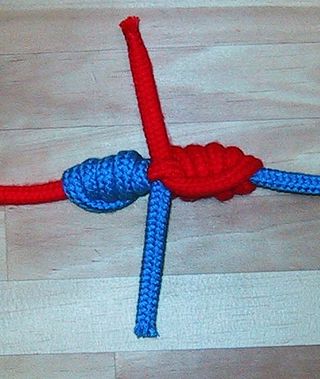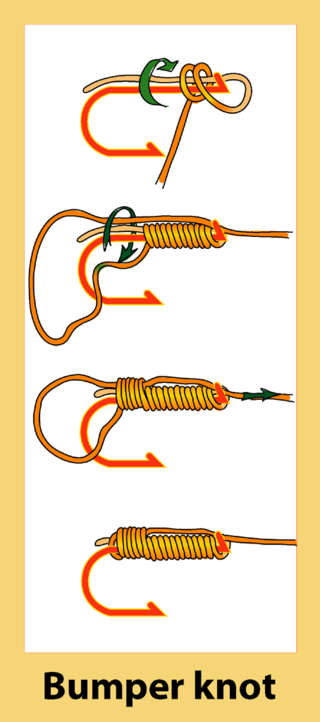
Trolling is a method of fishing where one or more fishing lines, baited with lures or bait fish, are drawn through the water. This may be behind a moving boat, or by slowly winding the line in when fishing from a static position, or even sweeping the line from side-to-side, e.g. when fishing from a jetty. Trolling is used to catch pelagic fish such as salmon, mackerel and kingfish.

A fishing line is a flexible, high-tensile cord used in angling to tether and pull in fish, in conjunction with at least one hook. Fishing lines are usually pulled by and stored in a reel, but can also be retrieved by hand, with a fixed attachment to the end of a rod, or via a motor.

Fly fishing is an angling technique that uses a ultralight-weight lure called an artificial fly, which typically mimics small invertebrates such as flying and aquatic insects to attract and catch fish. Because the mass of the fly lure is insufficient to overcome air resistance, it cannot be launched far using conventional gears and techniques, so specialized tackles are used instead and the casting techniques are significantly different from other forms of angling. It is also very common for the angler to wear waders, carry a hand net, and stand in the water when fishing.

Angling is a fishing technique that uses a fish hook attached to a fishing line to tether individual fish in the mouth. The fishing line is usually manipulated via a fishing rod, although rodless techniques such as handlining also exist. Modern angling rods are usually fitted with a fishing reel that functions as a cranking device for storing, retrieving and releasing out the line, although Tenkara fishing and traditional cane pole fishing are two rod-angling methods that do not use any reel. The fish hook itself can be additionally weighted with a denser tackle called a sinker, and is typically dressed with an appetizing bait to attract and entice the fish into swallowing the hook, but sometimes an inedible fake/imitation bait with multiple attached hooks is used instead of a single hook with edible bait. Some type of bite indicator, such as a float, a bell or a quiver tip, is often used to relay underwater status of the hook to the surface and alert the angler of a fish's presence.

A blood knot is a bend knot most usefully employed for joining sections of monofilament nylon line while maintaining a high portion of the line's inherent strength. Other knots used for this purpose can cause a substantial loss of strength. In fly fishing, this serves to build a leader of gradually decreasing diameter with the castable fly line attached at the large diameter end and the fly or hook at the small diameter end. The principal drawback to the blood knot is the dexterity required to tie it. It is also likely to jam, which is not a concern in fishing line, which is no great loss to cut, but may be a concern in normal rope. "Blood knot" may refer to "a double overhand knot tied in a cat-o'-nine-tails."
The barrel knot, called blood knot by Keith Rollo, is the best bend there is for small, stiff or slippery line. The ends may be trimmed short and the knot offers the least resistance possible when drawn through water.

The Cat's paw is a knot used for connecting a rope to an object. It is very similar to the cow hitch except there is an additional twist on each side of the bight, making it less prone to slipping.
The cat's-paw is the common hook hitch for slings. It is the same basic form as the bale sling hitch but has additional twists. Brady says "two or three altogether," and Steel, who mentioned the name in 1794, says "three twists." It is the best of all sling hitches and is often recommended for a slippery rope. But no hitch can slip when tied in a slings since it has no ends. All that is needed is a hitch that cannot jam, and this requirement the cat's-paw fills admirably. The knot spills instantly when removed from the hook. It is the hitch always used for heavy lifts.

A fishing lure is any of broad category of artificial angling baits that are inedible replicas designed to mimic real prey animals that attract the attention of predatory fish, typically via appearances, flashy colors, bright reflections, movements, vibrations and/or loud noises which appeal to the fish's predation instinct and entice it into striking the lure.

In fishing, a bumper knot can be used to secure soft or loose bait, including clusters of eggs, to a hook.

A fish hook or fishhook, formerly also called angle, is a hook used to catch fish either by piercing and embedding onto the inside of the fish mouth (angling) or, more rarely, by impaling and snagging the external fish body. Fish hooks are normally attached to a line, which tethers the target fish to the angler for retrieval, and are typically dressed with some form of bait or lure that entices the fish to swallow the hook out of its own natural instinct to forage or hunt.

A trotline is a heavy fishing line with shorter, baited branch lines commonly referred to as snoods suspending down at intervals using clips or swivels, with a hook at the free end of each snood.

The nail knot, also known as the tube knot or gryp knot, is mostly used in carp and fly-fishing. The nail knot was named because a nail was inserted as a guide when threading the line. Today, it is easier to use a small straw. The nail knot is an important fishing knot used to join two lines of different diameters and allows for line diameters to diminish down to the fly. I.E., it is useful for attaching your backing to the fly line, and your fly line to the leader, or tippet. The knot can be tied in multiple ways and is uniform.

Mormyshka is a sort of fishing lure or a jig. The word is derived from Russian word Mormysh meaning Freshwater Shrimp (Gammarus).

The Palomar knot is a knot that is used for securing a fishing line to a fishing lure, snap or swivel.

Fishing tackle is the equipment used by anglers when fishing. Almost any equipment or gear used in fishing can be called fishing tackle, examples being hooks, lines, baits/lures, rods, reels, floats, sinkers/feeders, nets, spears, gaffs and traps, as well as wires, snaps, beads, spoons, blades, spinners, clevises and tools that make it easy to tie knots.

Fishing techniques are methods for catching fish. The term may also be applied to methods for catching other aquatic animals such as molluscs and edible marine invertebrates.
Drop shotting is a highly finesse angling technique using plastic baits, consisting of a small thin-wire hook with a weight (sinker) attached to the tag end of the line. This is in contrast to the more traditional Texas Rig, where the weight slides inline, resting on the nose of the bait; or the Carolina Rig, where the weight is fixed above the bait. The dropshot rig provides the ability to keep a hook and lure off the bottom with a more "weightless"-looking posture. Usually the bait is fished by letting the weight hit the bottom and then twitch the rod tip, causing the lure to shake in a jumping-like action, but can also be flipped, dragged, hopped or jigged along the bottom. This simple but versatile technique has endless combinations with the different hooks, soft plastics and weights that can be used.[1] The aim is to present a free floating, slow twitching lure to induce a strike from non-aggressive fish. This rig is commonly used in bass fishing for catching smallmouth, largemouth and spotted bass, but can be used for a variety of other bottom-dwelling fish species, as well.
The snell knot is a hitch knot used in angling to attach a fishing line to the shank of a fishing hook. The line may still pass through the eye of the hook, but primarily fastens to the shaft. Hooks tied with a snell knot provide an even, straight-line pull to the fish. It is a very secure knot, but because it is easily tied using only the near end as the working end, it is used to attach a hook only to a leader, rather than directly to the main line.
Kite fishing is a fishing technique. It involves a kite from which a drop line hangs, attached to a lure or bait. The kite is flown over the surface of a body of water, and the bait floats near the waterline until taken by a fish. The kite then drops immediately, signaling to the fisherman that the bait has been taken, and the fish can then be hauled in. Kites can provide boatless fishermen access to waters that would otherwise be available only to boats. Similarly, for boat owners, kites provide a way to fish in areas where it is not safe to navigate - such as shallows or coral reef.
The San Diego jam knot is a common fishing knot used to tie a line to the hook, swivel, clip, or artificial fly. This knot is also known as the San Diego knot, reverse clinch knot or Heiliger knot.















